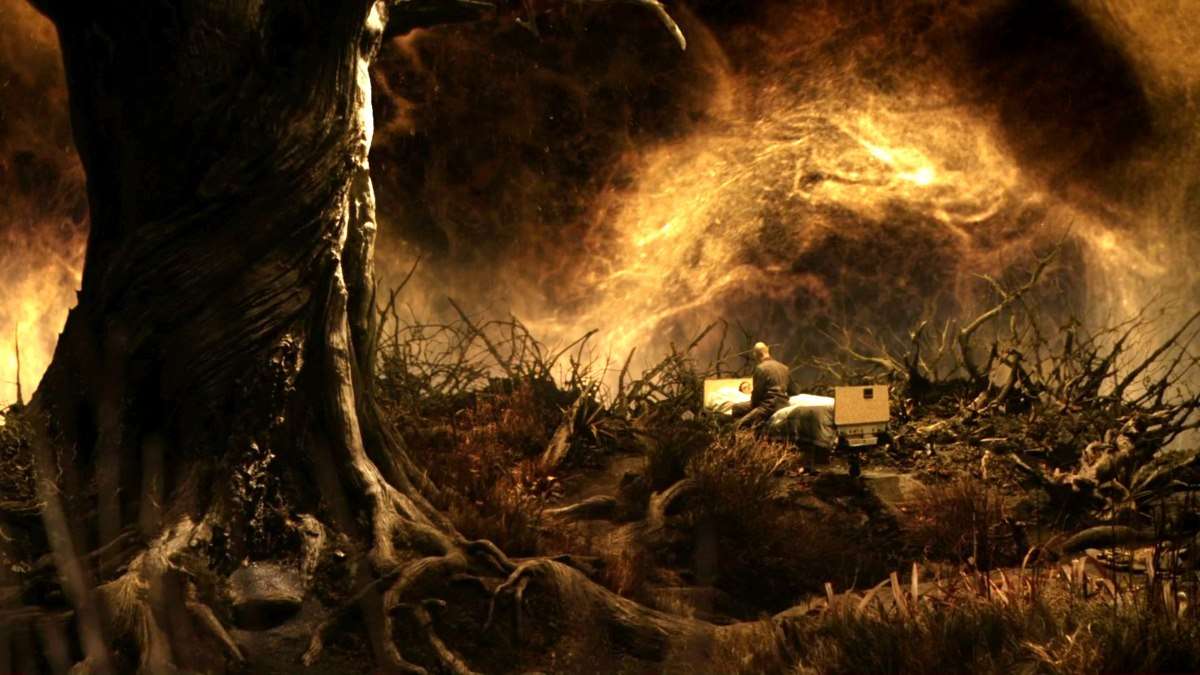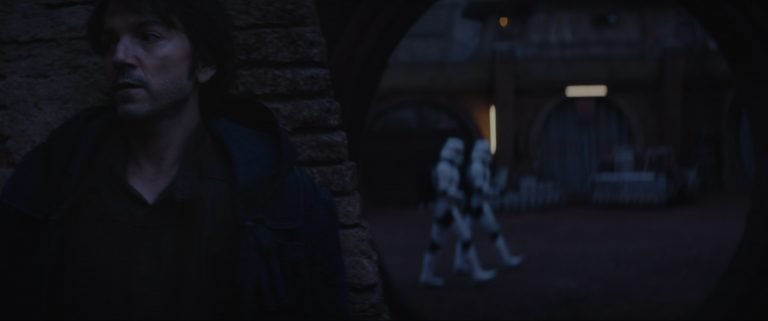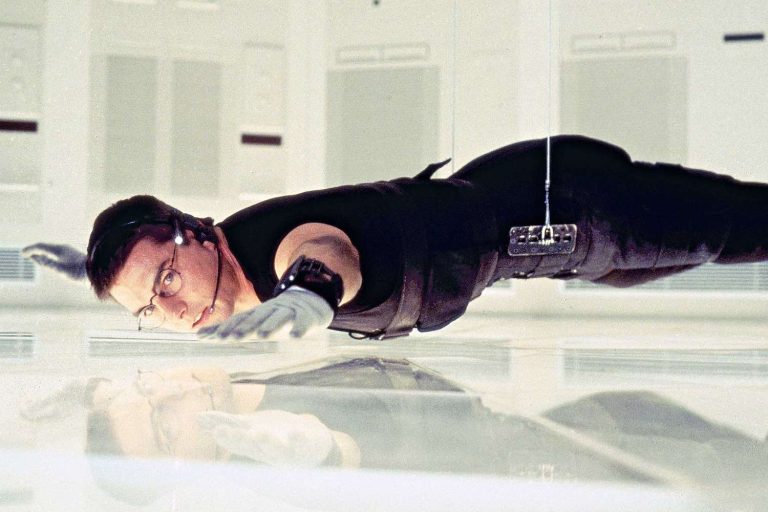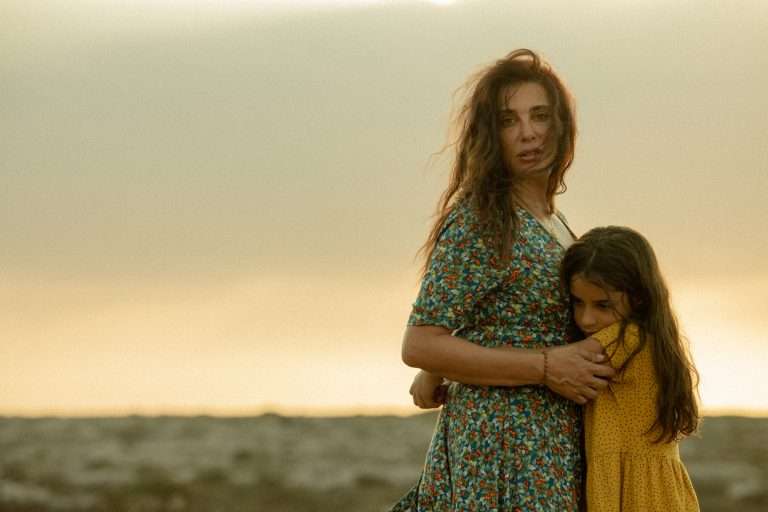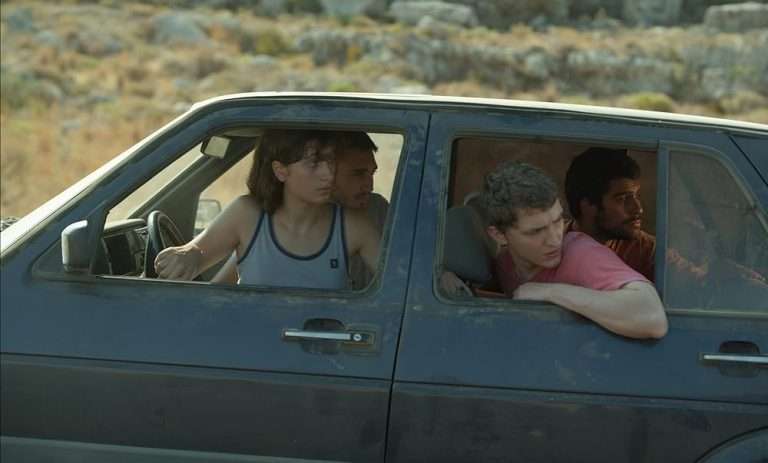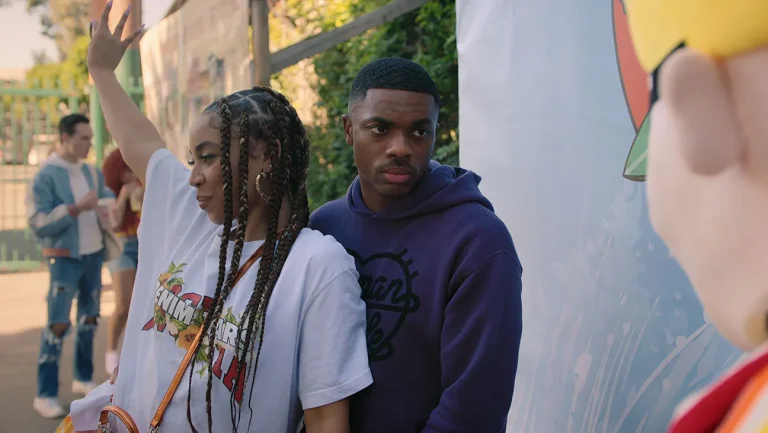The Fountain (2006) Movie Ending Explained & Themes Analyzed: Following the success of the indie hits Pi (1998) and Requiem for the Dream (2000), Darren Aronofsky opted to do a big-budget film. While the budget of his first two films was $600,000 and $4.5 million, respectively, Aronofsky’s third film, The Fountain’s initial proposed budget was $75 million. Based on Aronofsky’s own screenplay, the film was conceived as Aronofsky reached 30 and while reflecting on his parents’ cancer diagnosis (parents Abraham and Charlotte Aronofsky have appeared in minor roles in Aronofsky’s films, from Pi to mother!).
The Fountain was supposed to be shot in 2002 with a lead star cast of Brad Pitt and Cate Blanchett. However, creative differences between the actor and director led Brad Pitt to walk out of the film. While Mr. Pitt went to make Troy, Warner Bros. shelved the production of The Fountain. Giant sets for the film were built in Australia, and when the production stopped, they were auctioned off. In 2004, the project was resurrected, but with a halved budget of $35 million. Hugh Jackman and Rachel Weisz were brought in for the lead roles, and the script was revised and trimmed. Meanwhile, Darren Aronofsky turned his screenplay into a graphic novel illustrated by Kent Williams.
Despite braving all the production woes, Aronofsky eventually realized his goal. The primary wow factor of The Fountain is the organic VFX, which is made by filming chemical reactions in microscopic petri dishes. It’s a budget-appropriate alternative to CGI (and, in fact, looks gorgeous). Nevertheless, the film was a box office disaster, with a worldwide collection of only $16 million. Moreover, the critics’ appraisal was mixed, as with most of Darren Aronofsky’s films.
Read More: 12 Monkeys (1995) Movie Ending, Explained & Themes Analyzed
Unlike the spectacle cinema the filmmaker later made in 2014 (Noah), The Fountain is an unconventional drama, supposedly spanning nearly 1,000 years. It contemplatively deals with themes of mortality, love, grief, and obsession. While religious symbolism is a recurring element in Aronofsky’s films, in The Fountain, he deftly mixes Judeo-Christian, Mayan, and Buddhist elements and imagery. At its core, the film is about an individual coming to terms with death, accepting that the enduring cycle of birth and death is essential to sustain life. However, Aronofsky visualizes his message by brilliantly blending elements of historical drama and sci-fi fantasy. It might be confusing to some, demanding our time to read the multiple interpretations. Yet, this is Aronofsky at his most ambitious. Now let’s take a detailed at The Fountain’s plot, ending, and themes. Spoilers Ahead.
The Fountain (2006) Plot Summary:
A Quest across Time and Space
“The Fountain” (2006) opens with a quote from Genesis 3:24, which refers to the ‘Story of Fall,’ as Adam and Eve’s disobedience led to their banishment from the Garden of Eden, subsequently making them mortal. Darren Aronofsky has mentioned that mortality defines humanity, and this film is about a man’s deep inner journey to accept death and mortality. In the 16th century, conquistador Tomas Creo is in the jungles of South America, preparing himself to fight a group of Mayans and gain access to a pyramid. He reminisces about Queen Isabella and the ring she has gifted him.
Tomas is only accompanied by a couple of soldiers, and they try to run away immediately after the fierce Mayans ambush them. The two men are killed, while Tomas gets beaten up. But he manages to break away, and follow the Mayan priest to the top of the pyramid. There, he encounters the priest with a flaming sword, who stabs him. It is intercut with a bald 26th-century cosmonaut, Tom.
He travels through space inside a large life-supporting glass bubble that also has a dying tree. Tom uses the tree’s bark for sustenance and is haunted by the visions or memories of a woman. Then, the narrative cuts to present-day neuroscientist and surgeon Tommy Creo, who desperately tries to find a cure for cancer. He is desperate because he is about to lose his beloved wife, Izzi, to a brain tumor. But Tommy is so mired in his work that he can’t spend time with his wife.
What’s Dr. Creo’s Experiment is About?
When Izzi asks him to go for a walk with her, he rejects her proposal. He instead opts to do an experimental surgery on a monkey, which doesn’t get the desired results. But before euthanizing the monkey, Tommy thinks of mixing a compound extracted from an Old Guatemalan tree. After finishing the surgery, Tommy searches for his misplaced wedding ring. Subsequently, the doctor’s mentor and superior, Dr. Lillian Guzetti (Ellen Burstyn), meets and condemns him for his sloppy experimentations. Dr. Lillian believes he is getting reckless due to his personal attachment to this research project and suggests a break. But Tommy thinks there’s no point in taking a rest since he has to help Izzi avert death.
Back at home, Tommy finds Izzi stargazing on the snow-covered balcony. They look at a nebula engulfing a dying star. She says the Mayans called the golden nebula ‘Xibalba’ – ‘place of fear.’ In the Mayan mythology, it refers to the underworld, where dead souls go to be reborn. Furthermore, Izzi says she is writing about it in her book – a story that begins in 16th-century Spain. She is amazed at how the Mayans chose a dying star to represent their underworld. Later, Tommy finds that Izzi has lost sensitivity to hot and cold. He fears that her illness is at a very advanced stage. Before going to bed, Izzi gives her husband the almost finished manuscript of her book, titled “The Fountain.”
Izzi’s Story about a Conquistador
But Tommy gets a call and rushes to the lab. He sees the operated monkey, Donovan, looking well healed, and his cognitive abilities are twice what they used to be. They may have accidentally stumbled upon a solution for aging, but Tommy wasn’t conducting experiments to reverse aging. Unfortunately, the tumor in Donovan shows no positive or negative growth. While his colleagues rejoice at the findings, Tommy wants them to prepare another monkey to start the experimentation anew.
Tommy returns home and starts reading his wife’s book. It begins with the Grand Inquisitor Silecio’s (Stephen McHattie) plans to usurp the power of Spain’s Queen Isabella. He accuses the Queen of pursuing immortality. The inquisitor labels her followers as heretics and brutally punishes them. The Queen’s loyal conquistador, Tomas decides to assassinate the inquisitor Silecio. But he is stopped and brought to the palace for a private audience with the Queen. She warns him against killing the inquisitor since it will unite the European forces against her. Isabella calls for a priest, Avila of the Franciscan Order, who reveals the true reason for the inquisitor’s animosity against the Queen.
What does Queen Isabella Want?
Father Avila has returned from New Spain (Spain conquered regions of the Americas) with an extraordinary secret. This alleged treasure that could have been a boon to Spain was the source of the inquisitor’s dread. Hence, he is said to have staged the violent coup to dethrone her. What is the secret? Father Avila produces a dagger taken from a Mayan priest. This ceremonial dagger actually gives location to a secret region amidst the dense jungles of the Mayan kingdom. Avila speaks of a hidden pyramid, which houses a special tree on its top. The legend is that whoever drinks the tree’s sap will be rewarded with immortality. Tomas dismisses it as pagan beliefs, but Queen Isabella points out that something similar is mentioned in the Bible.
The Queen asks Tomas and his explorer-soldiers to go to New Spain and find the tree that offers eternal life. She believes it might liberate them from the looming dark forces. The Queen also gives him her ring, promising that she will be his Eve upon his triumphant return. The narrative cuts to Dr. Tommy Creo as the fictional Queen proclaims they will live together forever.
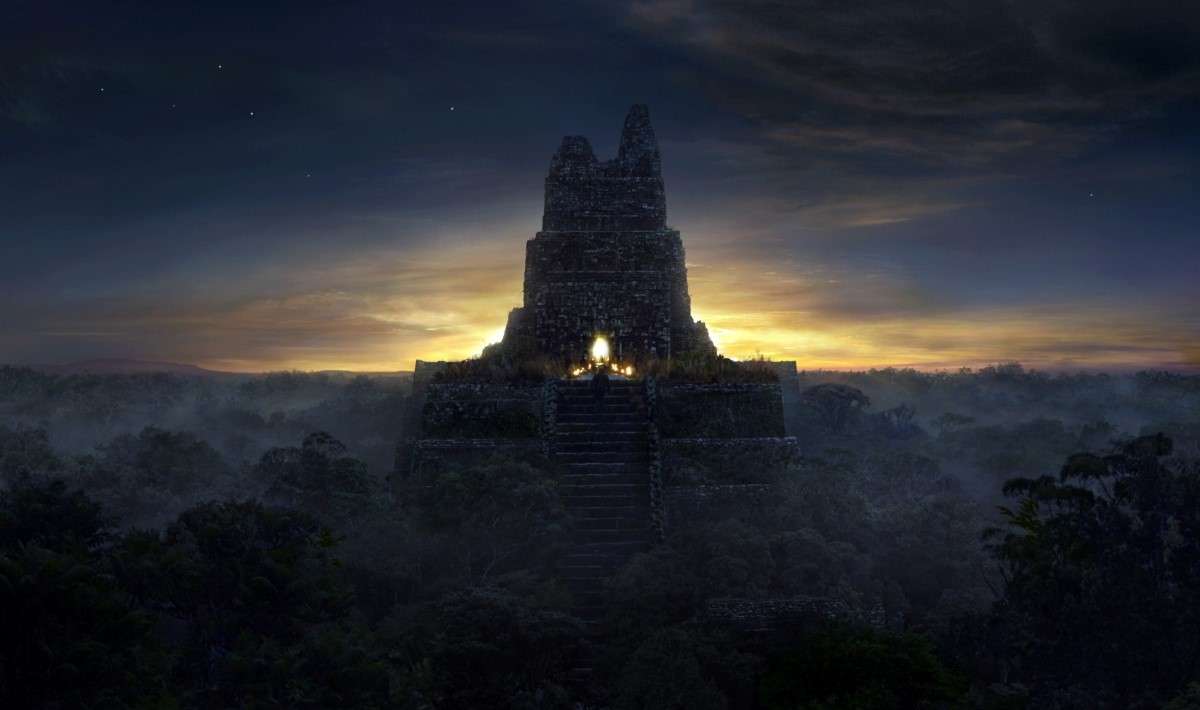
What is the Mayan Creation Myth?
Tommy meets Izzi at a museum gallery, where there are artifacts from the Mayan civilization. She points to a Mayan book, which explains a myth similar to the biblical version of the Tree of Life. According to the Mayan legend, the First Father – a human being – sacrificed himself to make the world as a Tree of Life sprouts from his body. First Father’s children took his head to the heavens, creating ‘Xibalba.’
The idea of death leading to an act of creation fascinates Izzi, which is also the basis of her story, “The Fountain.” While Izzi has accepted the inevitable, Tommy isn’t even ready to face the word ‘death.’ Soon, Izzi faints at the museum and is taken to a hospital. The doctor tells them that the tumor in Izzi’s brain is growing faster. The next seizure Izzi experiences might also be her last. However, Tommy dismisses it and says they have had a breakthrough and that there will be positive results soon.
When Tommy arrives at the lab, Dr. Lillian is seen examining the results of the groundbreaking experiment on Donovan. While everyone is enthusiastic about reversing or halting the aging process, Tommy sees that the tumor size remains the same in the new scans, too. In private, Dr. Lillian gets angry at Tommy for abandoning the results of their astounding discovery. Tommy breaks down, saying finding the cure for the tumor is his only priority. Lillian rightly points out that a discovery this big can’t be achieved overnight, and she asks him to be by Izzi’s bedside.
Why does Izzi Gift Tommy a Pen and Ink Set?
At the hospital, Tommy brings Izzi the manuscript of her book. When he says there’s been progress at his work, Izzi calls him “My Conquisdator.” She gifts him a pen and ink set to write the last chapter of her book. Understanding what Izzi is hinting at, Tommy feels a sense of dread. Izzi narrates him her conversation with a Mayan guide during the trip when she was researching for the book. She speaks of the guide – Moses Morales – planting a seed on his father’s grave, who became a part of the woods. He called death the “road to awe” – a phrase utilized by the Mayan priest in Izzi’s tale of the conquistador.
Tom, the cosmonaut in the future, assuages the dying tree, saying they are close to the nebula. Once the dying star explores, he believes the tree will be reborn and will bloom. At present, Tommy reads more of Izzi’s 16th-century story. Father Avila, lost in the jungles of the Americas, eventually stumbles upon the hidden pyramid. But at the camp, mutiny brews among Tomas’ men. They decide to kill Tomas since nothing will come out of this quest. Soon, Father Avila conveys the news about the pyramid. However, the soldiers attack the Father and Tomas. While the Father perishes in the onslaught, Tomas kills the rebellious soldiers. With only two soldiers accompanying him, Tomas is close to attaining the treasure.
Are Tommy Creo and the Cosmonaut the Same Person?
Izzi dies at the hospital. It also happens to be a moment of bitter irony as Dr. Lillian tells Tommy that the tumor in Donovan is shrinking. But now, nothing can bring back Izzi. It’s cut to a dejected cosmonaut since the tree is dying, though they are close to the supernova. At Izzi’s funeral, Tommy walks away while Dr. Lillian tries to memorialize her. He declares that death is a disease, and he will find a cure for it. At home, the grief-stricken Tommy uses ink and his blood to draw a wedding ring on his finger, which is still missing. In the future, the bald cosmonaut glances at the ink tattoos on his arms that symbolize his memories.
Did Dr. Tommy Creo find a cure for death and become immortal? Did he live for centuries and travel in a glass bubble across space with a tree planted on Izzi’s grave to seek rebirth in the proximity of a dying star? After Izzi’s death, Tommy returns to the lab in a few days. He considers the breakthrough in Donovan to be only a starting point. The doctor wants to eradicate aging and death. The cosmonaut has nearly reached ‘Xibalba.’ He is plagued by the memories of Izzi and the visions of the Queen from the story. As the glass biosphere is close to its target, the cosmonaut revisits the moment Izzi asks him to accompany her for a walk (before Donovan’s surgery).
The Fountain (2006) Movie Ending Explained:
What Happens to the Conquistador?
What if Tommy spent the time with her instead of running to the lab? As Tommy goes after Izzi, the cosmonaut finds the courage within him to shed his immortality. Assuming a meditative position, he floats in space to embrace the inevitable. This is cut to the 16th-century Mayan priest, who stops himself before delivering the fatal blow to the conquistador. He suddenly sees the vision of the levitating cosmonaut and calls him ‘First Father.’ The priest offers himself as a sacrifice to Tomas.
After killing the priest, he walks towards a pool with a large tree on the other end. Reaching the tree, Tomas applies the sap to his stab wound, which is instantly healed. He also drinks the sap, but instead of gaining immortality, plants start sprouting out of his body. In the process, Tomas gets killed, and a new life emerges from him. It’s an enactment of what Izzi explains to Tommy as the Mayan creation myth.
Did Dr. Creo Accept Death and Mortality?
In space, the tree dies, and the star explodes as the cosmonaut Tom has a final comforting vision of Izzi before embracing his death. The tree absorbs Tom’s corpse as it flourishes amidst the shower of exploding stars. At the end of “The Fountain,” Dr. Tommy Creo holds a seed, which is shown as if Izzi’s apparition hands it over to him. But it could be Izzi giving to him from one of her walks. Tommy plants it on Izzi’s grave and says, “Bye, Iz.”
The tale reaches its end. The past and the future might simply be yarns that push Tommy Creo to understand the cycle of life. Don’t they say the present is the only real thing? So, did Tommy move on with his life and stop obsessing over ‘curing’ death? While the conquistador’s tale was Izzi’s way of interpreting the cycle of life and making Tommy realize the same, how should we perceive the cosmonaut story? Is it really the immortal Dr. Tommy Creo floating in space? Or is it a highly imaginative reflection of Tommy’s inner journey to accept Izzi’s death? Let’s explore a little more.
Is Tommy Creo and Izzi’s Story the Only ‘Real’ One in the Film?
The three interconnected stories in Darren Aronofsky’s “The Fountain” (2006) showcase the search for the fountain of youth and immortality. While it’s clear that the story Izzy has written is her way of processing her own mortality, and hence not real, there are questions over how literal the futuristic cosmonaut’s journey is. There’s the suggestion that Tom is Dr. Tommy Creo, who has lived centuries after finding the ‘cure’ for death and is on a quest to revive Izzi. However, the film’s metaphorical brilliance becomes evident if the Cosmonaut’s story is perceived as something unfolding in present-day Tommy’s mind or subconscious.
Tom can be viewed as Tommy’s mental construct as he embarks on an enervating journey, struggling to accept that Izzi is dying. The glass bubble thing – Tommy’s mind – brings up fragments of Tommy’s memories about Izzi. When he is haunted by Izzi, she says, “Finish it,” referring to the last incomplete chapter in her book, an act which she hopes will help him realize the inevitability of death.
In fact, throughout “The Fountain,” Izzi attempts to make Tommy see death from her perspective (who has come to terms with it). Moreover, the past and future timelines meld towards the end, which indicates that it’s happening in Tommy’s mind. Since the past timeline is a fiction envisioned by Izzy, the cosmonaut appearing in the story also can’t be real. The melding more or less happens at a pivotal moment when Tommy eventually accepts death (“I’m going to die.”) and agrees to “Finish it.”
The Fade to White
The alternate version of the scene where Izzi asks Tommy to accompany her on a walk also suggests Tom’s acceptance of Izzi’s fate. He didn’t really travel back in time to make a different choice. It rather shows that Tommy has now realized he would opt to take a walk with Izzi in the snow instead of punishing himself by working in the lab. Eventually, when Dr. Tommy Creo buries the seed on his wife’s grave and bids her goodbye, he looks up to the sky and sees the nebula vanishing. It coincides with Tommy’s mental construct (cosmonaut) accepting mortality. The film ends with Aronofsky’s signature ‘fade to white’ as Tommy Creo says, “I finished it,” and assures, “Everything’s all right.”
The Fountain (2006) Movie Themes Analyzed:
Transcendence
Through the Mayan Creation Myth and their perception of the cosmos, “The Fountain” (2006) presents death as part of the cycle of life rather than an immutable end. The three characters’ – Tomas, Tommy, and Tom – quest for immortality eventually makes them comprehend that transcendence lies in accepting our mortality (in Tomas’ case, the lesson he learns is pretty brutal) and finding meaning in life through personal reflection. The notion of death and rebirth is prevalent in different religions, but Aronofsky’s approach is always more spiritual than dogmatic.
Fear of Death & Obsession
“The Fountain” (2006) chronicles the obsessive mission of a man who dreads death and wants to get rid of it. Obsession is a recurring theme of Aronofsky’s oeuvre and a driving force of his protagonists. However, in this film, Hugh Jackman’s character’s obsessive nature doesn’t entirely finish with tragedy. Of course, he can’t save his beloved wife. But by the end of “The Fountain,” Tommy Creo hasn’t entirely self-destructed himself, like the central characters in “Requiem for a Dream,” Randy in “The Wrestler,” or Nina in “Black Swan.” Despite facing a huge loss, there’s still hope for Tommy as he will continue to cherish his memories of Izzi.
For a scientist like Dr. Tommy Creo, death remains an inconquerable frontier. As a man who seeks certainty in life, death is incomprehensible. The fear of Izzi’s death strips away the comforts and security in Tommy’s life. He fears the possibility of continuing the life journey alone. This anxiety about death defines Tommy’s reckless pursuits and his inability to spend time with Izzy wholeheartedly. The burden he carries only perishes when Tommy embraces the finitude of life. Only when Tommy truly faces Izzi’s loss can he look beyond the pain and sorrow and find comfort in Izzi’s love and their shared memories.


